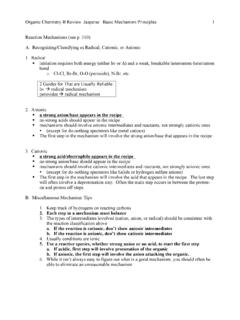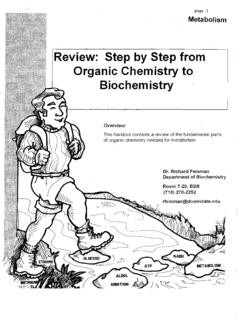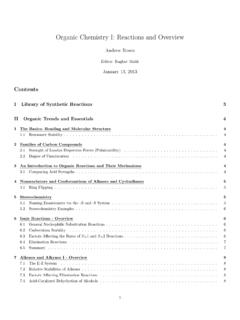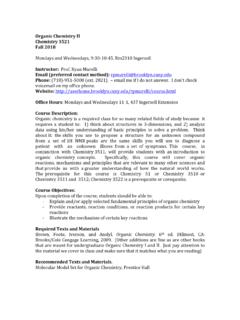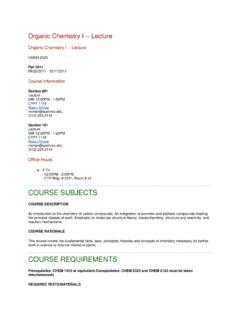Transcription of Organic Chemistry
1 Organic Chemistry Second Edition The INSTANT NOTES series Series Editor: Hames School of Biochemistry and Molecular Biology, University of Leeds, Leeds, UK. Animal Biology 2nd edition Biochemistry 2nd edition Bioinformatics Chemistry for Biologists 2nd edition Developmental Biology Ecology 2nd edition Immunology 2nd edition Genetics 2nd edition Microbiology 2nd edition Molecular Biology 2nd edition Neuroscience Plant Biology Chemistry series Consulting Editor: Howard Stanbury Analytical Chemistry Inorganic Chemistry 2nd edition Medicinal Chemistry Organic Chemistry 2nd edition Physical Chemistry Psychology series Sub-series Editor: Hugh Wagner Dept of Psychology, University of Central Lancashire, Preston, UK.
2 Psychology Forthcoming titles Cognitive Psychology Physiological Psychology Organic Chemistry Second Edition G. L. Patrick Department of Chemistry and Chemical Engineering, Paisley University, Paisley, Scotland This edition published in the Taylor & Francis e-Library, 2005. "To purchase your own copy of this or any of Taylor & Francis or Routledge's collection of thousands of eBooks please go to . Garland Science/BIOS Scienti c Publishers, 2004. First published 2000. Second edition published 2004. All rights reserved. No part of this book may be reproduced or transmitted, in any form or by any means, without permission.
3 A CIP catalogue record for this book is available from the British Library. ISBN 0-203-42761-0 Master e-book ISBN. ISBN 0-203-44168-0 (Adobe eReader Format). ISBN 1 85996 264 5 (Print Edition). Garland Science/BIOS Scienti c Publishers 4 Park Square, Milton Park, Abingdon, Oxon OX14 4RN, UK and 29 West 35th Street, New York, NY 10001 2299, USA. World Wide Web home page: Garland Science/BIOS Scienti c Publishers is a member of the Taylor & Francis Group Distributed in the USA by Ful lment Center Taylor & Francis 10650 Toebben Drive Independence, KY 41051, USA. Toll Free Tel.: +1 800 634 7064; E-mail: Distributed in Canada by Taylor & Francis 74 Rolark Drive Scarborough, Ontario M1R 4G2, Canada Toll Free Tel.
4 : +1 877 226 2237; E-mail: Distributed in the rest of the world by Thomson Publishing Services Cheriton House North Way Andover, Hampshire SP10 5BE, UK. Tel.: +44 (0)1264 332424; E-mail: Library of Congress Cataloging-in-Publication Data Patrick, Graham L. Organic Chemistry / Patrick. 2nd ed. p. cm. (Instant notes series). Includes bibliographical references and index. ISBN 1-85996-264-5 (alk. paper). 1. Chemistry , Organic Outlines, syllabi, etc. I. Title: Instant notes Organic Chemistry . II. Title. III. Series. 2003. 547 dc22. Production Editor: Andrew Watts C ONTENTS. Preface ix Section A Structure and bonding 1.
5 A1 Atomic structure of carbon 1. A2 Covalent bonding and hybridization 3. A3 sp3 Hybridization 5. A4 sp2 Hybridization 8. A5 sp Hybridization 14. A6 Bonds and hybridized centers 17. Section B Alkanes and cycloalkanes 19. B1 De nition 19. B2 Drawing structures 20. B3 Nomenclature 22. Section C Functional groups 27. C1 Recognition of functional groups 27. C2 Aliphatic and aromatic functional groups 29. C3 Intermolecular bonding 30. C4 Properties and reactions 33. C5 Nomenclature of compounds with functional groups 35. C6 Primary, secondary, tertiary and quaternary nomenclature 43.
6 Section D Stereochemistry 45. D1 Constitutional isomers 45. D2 Con gurational isomers alkenes and cycloalkanes 46. D3 Con gurational isomers optical isomers 49. D4 Conformational isomers 56. Section E Nucleophiles and electrophiles 63. E1 De nition 63. E2 Charged species 64. E3 Neutral inorganic species 66. E4 Organic structures 69. Section F Reactions and mechanisms 73. F1 Reactions 73. F2 Mechanisms 75. Section G Acid base reactions 79. G1 Br nsted Lowry acids and bases 79. G2 Acid strength 82. G3 Base strength 88. G4 Lewis acids and bases 94. G5 Enolates 95. vi Contents Section H Alkenes and alkynes 99.
7 H1 Preparation of alkenes and alkynes 99. H2 Properties of alkenes and alkynes 101. H3 Electrophilic addition to symmetrical alkenes 105. H4 Electrophilic addition to unsymmetrical alkenes 112. H5 Carbocation stabilization 115. H6 Reduction and oxidation of alkenes 117. H7 Hydroboration of alkenes 121. H8 Electrophilic additions to alkynes 124. H9 Reduction of alkynes 127. H10 Alkylation of terminal alkynes 129. H11 Conjugated dienes 131. Section I Aromatic Chemistry 135. I1 Aromaticity 135. I2 Preparation and properties 137. I3 Electrophilic substitutions of benzene 139. I4 Synthesis of mono-substituted benzenes 147.
8 I5 Electrophilic substitutions of mono-substituted aromatic rings 150. I6 Synthesis of di- and tri-substituted benzenes 160. I7 Oxidation and reduction 164. Section J Aldehydes and ketones 167. J1 Preparation 167. J2 Properties 169. J3 Nucleophilic addition 173. J4 Nucleophilic addition charged nucleophiles 175. J5 Electronic and steric effects 181. J6 Nucleophilic addition nitrogen nucleophiles 184. J7 Nucleophilic addition oxygen and sulfur nucleophiles 187. J8 Reactions of enolate ions 191. J9 -Halogenation 198. J10 Reduction and oxidation 200. J11 , -Unsaturated aldehydes and ketones 202.
9 Section K Carboxylic acids and carboxylic acid derivatives 205. K1 Structure and properties 205. K2 Nucleophilic substitution 209. K3 Reactivity 213. K4 Preparations of carboxylic acids 217. K5 Preparations of carboxylic acid derivatives 219. K6 Reactions 224. K7 Enolate reactions 234. Section L Alkyl halides 239. L1 Preparation and physical properties of alkyl halides 239. L2 Nucleophilic substitution 242. L3 Factors affecting SN2 versus SN1 reactions 247. L4 Elimination 252. L5 Elimination versus substitution 256. L6 Reactions of alkyl halides 258. L7 Organometallic reactions 261.
10 Contents vii Section M Alcohols, phenols, and thiols 263. M1 Preparation of alcohols 263. M2 Preparation of phenols 264. M3 Properties of alcohols and phenols 266. M4 Reactions of alcohols 270. M5 Reactions of phenols 277. M6 Chemistry of thiols 281. Section N Ethers, epoxides, and thioethers 283. N1 Preparation of ethers, epoxides, and thioethers 283. N2 Properties of ethers, epoxides, and thioethers 286. N3 Reactions of ethers, epoxides, and thioethers 289. Section O Amines and nitriles 295. O1 Preparation of amines 295. O2 Properties of amines 299. O3 Reactions of amines 305.

